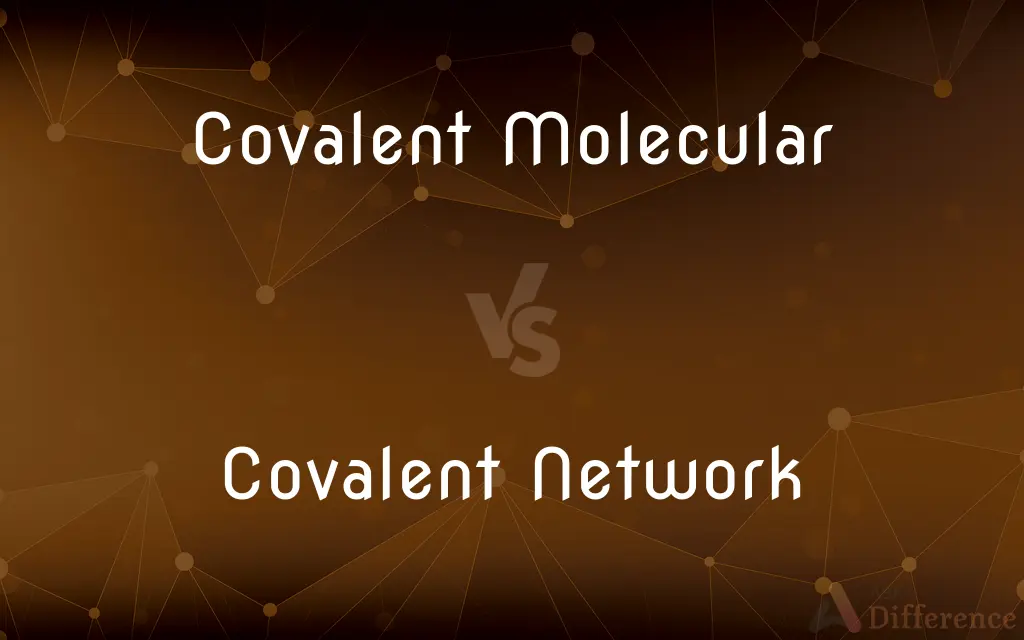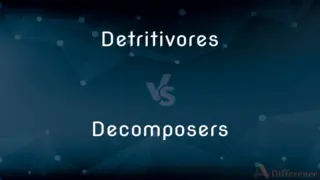Covalent Molecular vs. Covalent Network — What's the Difference?
By Tayyaba Rehman — Published on December 26, 2023
Covalent Molecular structures consist of discrete molecules bonded nonmetals, like H₂O. Covalent Network structures are extended, 3D networks of atoms bonded covalently, like diamond. Both involve covalent bonds but differ in structural arrangement.

Difference Between Covalent Molecular and Covalent Network
Table of Contents
ADVERTISEMENT
Key Differences
Covalent Molecular refers to substances where atoms, usually nonmetals, share electrons to form discrete molecules. These molecules are held together by weak intermolecular forces in the solid or liquid state. Covalent Network, in contrast, is characterized by a continuous three-dimensional network of covalently bonded atoms, without discrete molecules.
For instance, water (H₂O) and methane (CH₄) are examples of Covalent Molecular substances. They consist of distinct molecules that are not covalently bonded to each other. In contrast, Covalent Network substances, like diamond or silicon dioxide, have atoms covalently bonded in an extensive network, extending indefinitely in all directions.
Another difference lies in their physical properties. Covalent Molecular substances typically have lower melting and boiling points due to the weaker forces between their discrete molecules. They may also be gases, liquids, or soft solids at room temperature. Covalent Network substances, on the other hand, usually have high melting and boiling points since breaking them requires breaking strong covalent bonds.
In summary, while both Covalent Molecular and Covalent Network structures involve covalent bonds, the difference lies in the arrangement and bonding continuity. Covalent Molecular structures are composed of individual molecules, whereas Covalent Network structures are continuous networks of covalently bonded atoms.
Comparison Chart
Basic Structure
Discrete molecules.
Continuous 3D network of atoms.
ADVERTISEMENT
Examples
H₂O, CH₄, CO₂.
Diamond, quartz (silicon dioxide).
Melting/Boiling Points
Generally lower due to weak intermolecular forces.
High, as breaking them involves breaking covalent bonds.
Physical State at Room Temp
Can be gases, liquids, or soft solids.
Usually hard solids.
Intermolecular Forces
Present between individual molecules.
Absent, as there are no discrete molecules in the structure.
Compare with Definitions
Covalent Molecular
The forces between the molecules are usually weak.
Molecular oxygen (O₂) has weak forces between its molecules.
Covalent Network
These substances typically have high melting and boiling points.
Silicon carbide (SiC) has a high melting point due to its Covalent Network structure.
Covalent Molecular
They are typically formed between nonmetals.
Nitrogen gas (N₂) is a Covalent Molecular substance.
Covalent Network
They consist of atoms covalently bonded in extended structures.
Quartz consists of a Covalent Network of silicon and oxygen atoms.
Covalent Molecular
They often have low melting and boiling points.
Argon (Ar) is a Covalent Molecular gas at room temperature.
Covalent Network
Covalent Network structures form a continuous 3D lattice.
Diamond is a Covalent Network of carbon atoms.
Covalent Molecular
Covalent Molecular compounds consist of discrete covalently bonded molecules.
Water (H₂O) is a Covalent Molecular compound.
Covalent Network
They are generally hard and rigid substances.
Boron nitride (BN) is a hard material due to its Covalent Network structure.
Covalent Molecular
They can exist in various states at room temperature.
Carbon dioxide (CO₂) sublimates from a solid to a gas.
Covalent Network
There are no discrete molecules in these structures.
In graphite, a Covalent Network of carbon atoms forms layers.
Common Curiosities
What's the primary structure in Covalent Molecular compounds?
Covalent Molecular compounds consist of discrete, individual molecules.
Can Covalent Molecular substances be gases?
Yes, many Covalent Molecular substances, like oxygen (O₂), are gases at room temperature.
How is the Covalent Network structure distinct?
Covalent Network structures form a continuous 3D lattice of covalently bonded atoms.
Do Covalent Molecular compounds have high melting points?
Generally, they have lower melting points due to weaker intermolecular forces between molecules.
Are all Covalent Network substances insulators?
Mostly, but graphite, a Covalent Network substance, conducts electricity due to delocalized electrons.
Why do Covalent Network structures have high boiling points?
Breaking them into separate entities requires breaking strong covalent bonds.
Why are Covalent Network structures generally hard?
They are hard due to the continuous covalent bonds that need to be broken to deform them.
Can Covalent Network structures be soft?
Typically, they're hard and rigid, but some, like graphite, have layers that can slide over each other.
What's an example of a Covalent Molecular liquid?
Water (H₂O) is an example of a Covalent Molecular liquid.
Can Covalent Molecular substances be solid at room temperature?
Yes, substances like iodine (I₂) are solid Covalent Molecular compounds at room temperature.
Are there any gases with Covalent Network structures?
No, due to their extensive covalent bonding, they're typically solid at room temperature.
Do Covalent Network substances always contain only one type of atom?
No, they can contain different types of atoms, like silicon dioxide (SiO₂) which has silicon and oxygen.
What forces hold Covalent Molecular substances together?
Weak intermolecular forces hold the discrete molecules together.
Are there any Covalent Network structures that are not solids?
Typically, Covalent Network structures are solids due to their extensive covalent bonding.
Can Covalent Molecular structures conduct electricity?
Generally, no, because they lack free-moving charges.
Share Your Discovery

Previous Comparison
Detritivores vs. Decomposers
Next Comparison
Care For vs. Care AboutAuthor Spotlight
Written by
Tayyaba RehmanTayyaba Rehman is a distinguished writer, currently serving as a primary contributor to askdifference.com. As a researcher in semantics and etymology, Tayyaba's passion for the complexity of languages and their distinctions has found a perfect home on the platform. Tayyaba delves into the intricacies of language, distinguishing between commonly confused words and phrases, thereby providing clarity for readers worldwide.
















































